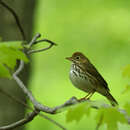en
names in breadcrumbs


Several subspecies of Seiurus aurocapilla are generally recognized, reflecting minor variations in the color of the upperparts. However, these subspecies are controversial. The subspecies S. a. furvior, found in Newfoundland, and S. a. cinereus, found in the western part of its range, are generally recognized. Authorities do not often recognize the subspecies S. a. canivirens, found in southern Appalachia. (Dunn & Garrett, 1997)
Perception Channels: visual ; tactile ; acoustic ; chemical
Due to its need for large continuous forest tracts, S. aurocapilla is sensitive to forest fragmentation of its breeding habitat and wintering grounds. In breeding grounds, fragmentation of forest decreased suitable breeding sites and increases cowbird parasitism, to which S. aurocapilla is very susceptible. Towers, windows, and other human structures take a large toll on migrating S. aurocapilla. (Ehrlich, Dobkin, & Wheye, 1988; Dunn & Garrett, 1997; Link & Hahn, 1996)
US Migratory Bird Act: protected
US Federal List: no special status
CITES: no special status
State of Michigan List: no special status
IUCN Red List of Threatened Species: no special status
Seiurus aurocapilla is well studied by scientists in North America, partly due to its need for large mature forest tracts. Birdwatchers will travel to rural areas with large forest tracts to observe S. aurocapilla. (Dunn & Garrett, 1997)
Seiurus aurocapilla eats insects, spiders, snails, and worms, primarily while walking on the floor of deciduous of mixed broadleaf-conifer forest among the leaf litter and fallen logs. In spruce budworm outbreaks, S. aurocapilla will feed in trees. Seeds and other vegetation sometimes make up part of its fall and winter diet. Seiurus aurocapilla will search for food based on prey distribution. It will learn where there are areas of high prey density and repeatedly revisit those sites. (Ehrlich, Dobkin, & Wheye, 1988; Dunn & Garrett, 1997; Van Horn & Donovan, 1994)
Seiurus aurocapilla breeds throughout much of the eastern United States and Canada. Along the east coast, S. aurocapilla ranges from southeastern Newfoundland in Canada to northern North Carolina. In Canada, it can be found as far west as central and northern Alberta and as far north as James Bay in the east and southern Northwest Territories in the west. In the United States, S. aurocapilla ranges west to central Minnesota down to western Arkansas, extending in some places west to central Montana and Colorado. Seiurus aurocapilla winters in Mexico, Central America, and the Caribbean, although on some occasions will overwinter in the southeastern United States west to Texas. (Dunn & Garrett, 1997; National Geographic, 1999)
Biogeographic Regions: nearctic (Native ); neotropical (Native )
Seiurus aurocapilla is found in mature deciduous or mixed broadleaf-conifer forest with little undergrowth, and occasionally pine forests. Breeding habitats are relatively dry uplands or slopes, although they have been noted to breed in bottomland forests and swampy areas. An abundance of leaf litter on the forest floor is essential for foraging and nest building. Seiurus aurocapilla requires relatively large contiguous forest tracts for breeding. (Ehrlich, Dobkin, & Wheye, 1988; Dunn & Garrett, 1997)
Terrestrial Biomes: forest
Average lifespan
Status: wild: 132 months.
Seiurus aurocapilla is a large, thrushlike warbler, that is approximately 5.75 - 6 inches (14 -- 15 cm) long and has a mass of approximately 21 grams. It is olive to olive-gray above and white below, with bold black spotting on the underparts aligned into rows. Adult S. aurocapilla has a bold white eye-ring, thin blackish malar stripe, and blackish lateral crown stripes bordering a dull orange central crown stripe. The eye of S. aurocapilla is large and thrushlike, and the legs are pinkish, stout, and long. Males and females have similar plumage. Immature S. aurocapilla are less brightly colored, often with broader olive crown stripes. (Dunn & Garrett, 1997; Van Horn & Donovan, 1994)
Average mass: 21 g.
Other Physical Features: endothermic ; bilateral symmetry
Seiurus aurocapilla generally breeds in mature deciduous or mixed broadleaf-conifer forest tracts with little undergrowth, but will occasionally breed in pine forests. Seiurus aurocapilla requires relatively large contiguous forest areas for breeding. The male S. aurocapilla displays above and near the female; often the male pursues the female in a wild courting flight, singing throughout the flight. The male ascends 10--60 feet (3--21 meters) above the treetop level and hovers and flutters with spread wings and tail while singing. The nest of S. aurocapilla is built in the open, on leaf-covered floor of deciduous woods or just above the ground in a clump of low plants or shrubs. Often the nest is placed next to an opening in the forest. The nest is shaped like a Dutch oven, and is the source of the common name "ovenbird." It is built of dried grass, leaves, moss, other vegetative matter, and hair. The nest is well camouflaged with leaves, branches, and other litter placed on the roof. The entrance is a small slit on the side of the nest. Eggs are white with brown and gray markings, and about 0.8 inches (2 cm) long. Seiurus aurocapilla occasionally has two broods, and even three when spruce budworms are abundant. Females incubate the eggs and flushes only when approached closely and then will perform a distraction display. (Ehrlich, Dobkin, & Wheye, 1988; Dunn & Garrett, 1997; Zach & Falls, 1975)
Key Reproductive Features: iteroparous ; gonochoric/gonochoristic/dioecious (sexes separate); sexual ; oviparous